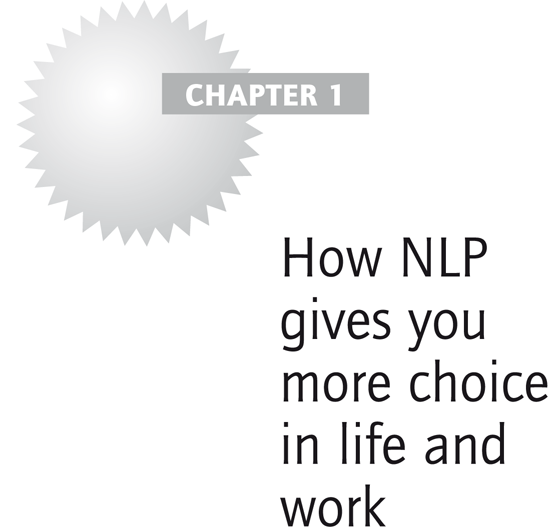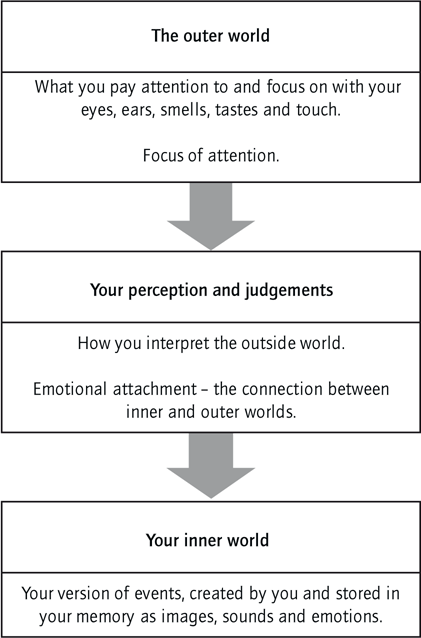
Think about a time when you felt really good about something you did and describe the feeling. What caused you to feel this way? How about the opposite feeling? Can you recall a time when you didn’t feel so good about an experience? How well did you manage or cope with the situation? When you compare these scenarios, like most people, you realise that worthy achievements are driven by a sense of what’s possible and a positive emotional state. Whether making money, passing an exam, learning a new skill or starting a new phase of life, feelings of confidence and achievement are strongest when driven by personal effort and passion.
Whichever way you look at it, we use imagination and positive states to feel good and drive us to achieve. In contrast, negative states hold you back by filling you with caution, anxiety, fear, uncertainty and insecurity. We are all capable of generating both negative and positive states. We are all capable of using our imagination to conjecture desirable futures and for seeing the worst that could possibly happen. We are all capable and we also all have choice.
Given that we have choice to think in whatever way we wish, some choose to focus on the downsides: what could go wrong; how this probably won’t turn out OK. Others focus on the positives, imagining how things can work out well. Some people like to plan meticulously whilst others seem to live for each moment, preferring a more spontaneous lifestyle. Some people like to think deeply before acting whilst others are happier leaping into action without too much forethought. We exercise choice about what we do and how we do it many times throughout a typical day, but sometimes it may seem like we are not exercising choice at all because, over time, the choices we make become hard-to-shift habits.
So how much choice do you really have? Or perhaps a more apt question might be, ‘How much of what you do each day is driven by habit, and which habits could you do without?’ This is one area where NLP works magic, by taking habits that are not serving you well and re-programming them so you can be effective in more life and work situations. There’s a popular myth that it takes at least 30 days to change a habit. Whilst this may be true by conventional methods, people have been using NLP techniques to change their strongest habits in a few days only, sometimes in less than an hour and in many cases just a few minutes. How is this possible?
When was the last time you questioned why you did something you were unhappy with? Maybe you flunked a test, had an argument with a colleague, got stressed about being late, presented poorly or acted inappropriately. Immediately after the situation, did you ask yourself why? This question might get to your core motivation for doing what you did but, if you want to change your habit, you need to be asking ‘How?’
Joe’s marriage had broken down and he got passed over for promotion twice at work. He began to feel the world was conspiring against him so he decided to start afresh.
He moved to a new town, found a new job and started all over. He immediately felt good having left behind all his problems, but, within a year, things were going off-track again. The same patterns were occurring. The future for his job was in question and he was dumped by a girlfriend he met six months previously.
Joe made the common mistake that many people make: blaming other people and situations for his misfortunes. This helped him feel better in the short term, but what Joe really needed was to look in the mirror for the things that he had been doing to sabotage his best efforts, to identify the habits that were causing the problem.
Joe’s example reminds us that the changes we make on the inside help us to make the most of opportunities and challenges in the outside world. Joe eventually took an NLP Practitioner course and discovered how he had been re-creating his misfortune, initially by the way he had been thinking and acting towards others (including his ex-wife). He changed the way he perceived other people, learned to communicate more effectively and re-programmed some of the habits that used to get him into difficult situations. In essence, he used NLP to generate more choices to interact with the world differently. Joe is now settled in a loving relationship and has started his own business doing something he really enjoys.
There is a saying in NLP which you may have heard before, ‘If what you are doing isn’t working, try something else’. The ‘something else’ is ideally the ‘difference that makes the difference’, and often this is a very small change. You need to know what to change, and you get to this by reversing the thought process and learning about the way you have been relating to the outer world. For example, when you feel bad, how you made yourself feel bad is a typical NLP line of enquiry, as opposed to what you are feeling bad about, since your feelings are a result of how you have interpreted events in the outside world and are now representing them this way on the inside. Every time you infer a meaning or make a judgement you are exercising choice. The question is ‘are the choices you are making getting you the results you want?’
Charlotte enjoyed her job as a sales executive selling IT services. She admired the top sales people when they won big seven-figure deals and aspired to be like them. The way to do this was to engage client directors, but Charlotte couldn’t muster the confidence to approach them. She would come up with all kinds of silly excuses to procrastinate rather than pick up the phone to get an appointment. Her standard phrase to explain this dilemma was, ‘I’m not a confident person’. Underlying this were all manner of limiting beliefs about directors either not being interested or being too busy, or that she may not be credible in male dominated boardrooms being a young blonde woman.
Charlotte became an NLP practitioner and, in the process, learned a variety of techniques to identify and change the limiting belief ‘I’m not a confident person’ that had been keeping confidence out of her reach. She rapidly grew her confidence and soon had a number of directors in her warm contacts list. This changed her results and, most importantly for Charlotte, she was able to realise her ambition as she saw the value of her commission cheques rise meteorically.
We all live in the same world, but people perceive the world in different ways according to their experience and the influence of others. Many of your interpretations exist outside of awareness, so the first step in NLP training is to grow your awareness, and then you can make some simple yet profound positive changes that have a real impact on the outer world.

NLP is also good for stretching your capability to succeed in any endeavour. Our clients are testament to this: some have used their NLP skills to start new ventures later in life, others have secured high-level promotions. Our corporate clients are using their NLP skills to engage their employees, communicate effectively, coach executives and lead change initiatives. Many individuals have used their NLP skills to improve health, others to recover quickly from debilitating injuries and illnesses. Parents use their NLP skills to be the best parents ever, raising their children to be confident and cooperative individuals. NLP offers everyone a way to generate more choice, to be more flexible, to feel confident and to face the world on its terms.
You can get a glimpse of your fullest potential through your imagination, a central dynamic of NLP. One of the major changes people make after learning NLP is to raise the bar of their personal achievement. Suddenly things seem so much easier to accomplish than ever before. As you progress through this book you will learn how to use your imagination to create your own positive changes.
In the following chapters you will be introduced to the various parts of NLP that make up a wide and deep topic with a growing number of highly effective techniques to significantly enhance learning, communication and change. As you read the book, keep in mind something that you would like to change or you really want to achieve, and do the exercises with this thought in mind.

In this chapter you have learned learned: